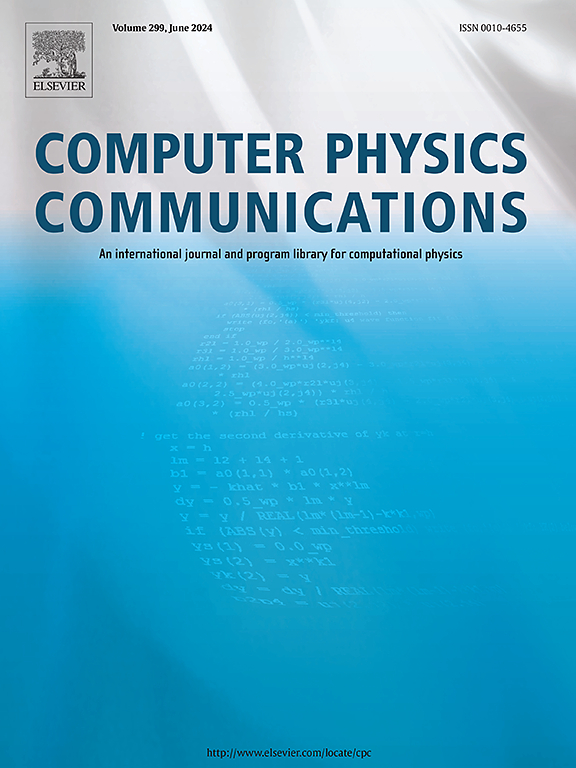quTARANG: A high-performance computing Python package to study turbulence using the Gross-Pitaevskii equation
IF 7.2
2区 物理与天体物理
Q1 COMPUTER SCIENCE, INTERDISCIPLINARY APPLICATIONS
引用次数: 0
Abstract
We present quTARANG, a robust GPU-accelerated Python package developed for a comprehensive study of turbulence problems in Bose-Einstein condensates (BECs). It solves the mean-field Gross-Pitaevskii equation (GPE) using a Time-splitting pseudo-spectral (TSSP) scheme and ground state calculations are performed using a Backward Euler spectral (BESP) scheme. quTARANG also has post-processing tools that can compute different statistical properties of turbulent Bose-Einstein condensates, such as kinetic energy spectra, particle number spectrum and corresponding fluxes. This paper provides detailed descriptions of the code, along with specific examples for calculating the ground state and turbulent state of the condensate under different initial conditions for both 2-D and 3-D cases. We also present results on the dynamics of the GPE in 2-D and 3-D used to validate our code. Finally, we compare the performance of quTARANG on different GPUs to its performance on a CPU, demonstrating the speedup achieved on various GPU architectures.
Program summary
Program Title: quTARANG
CPC Library link to program files: https://doi.org/10.17632/s6xh86fkcm.1
Developer's repository link: https://github.com/sachinrawat2207/quTARANG
Licensing provisions: MIT
Programming language: Python
Nature of problem: This software is designed to compute the ground state and dynamical evolution of the Gross-Pitaevskii equation for 2-D and 3-D cases with GPU acceleration.
Solution method: We have used a Time-splitting pseudo-spectral (TSSP) scheme to compute the dynamics and Backward Euler Pseudo-spectral (BESP) scheme used to compute the ground state of the system by evolving the system in imaginary time.
quTARANG:一个高性能计算Python包,用于使用Gross-Pitaevskii方程研究湍流
我们提出quTARANG,一个鲁棒的gpu加速Python包开发在玻色-爱因斯坦凝聚(BECs)湍流问题的全面研究。采用分时伪谱(TSSP)格式求解平均场Gross-Pitaevskii方程(GPE),采用后向欧拉谱(BESP)格式进行基态计算。quTARANG还具有后处理工具,可以计算湍流玻色-爱因斯坦凝聚体的不同统计特性,如动能谱、粒子数谱和相应的通量。本文对程序进行了详细的描述,并给出了二维和三维情况下不同初始条件下凝结水基态和湍流态的具体计算实例。我们还提供了用于验证代码的2-D和3-D GPE动力学结果。最后,我们比较了quTARANG在不同GPU上的性能与其在CPU上的性能,展示了在不同GPU架构上实现的加速。程序摘要程序标题:quTARANGCPC库链接到程序文件:https://doi.org/10.17632/s6xh86fkcm.1Developer's存储库链接:https://github.com/sachinrawat2207/quTARANGLicensing条款:mit编程语言:python问题性质:该软件旨在计算具有GPU加速的2-D和3-D情况下的Gross-Pitaevskii方程的基态和动态演化。求解方法:采用分时伪谱(TSSP)格式计算动力学,采用后向欧拉伪谱(BESP)格式通过虚时间演化计算系统基态。
本文章由计算机程序翻译,如有差异,请以英文原文为准。
求助全文
约1分钟内获得全文
求助全文
来源期刊

Computer Physics Communications
物理-计算机:跨学科应用
CiteScore
12.10
自引率
3.20%
发文量
287
审稿时长
5.3 months
期刊介绍:
The focus of CPC is on contemporary computational methods and techniques and their implementation, the effectiveness of which will normally be evidenced by the author(s) within the context of a substantive problem in physics. Within this setting CPC publishes two types of paper.
Computer Programs in Physics (CPiP)
These papers describe significant computer programs to be archived in the CPC Program Library which is held in the Mendeley Data repository. The submitted software must be covered by an approved open source licence. Papers and associated computer programs that address a problem of contemporary interest in physics that cannot be solved by current software are particularly encouraged.
Computational Physics Papers (CP)
These are research papers in, but are not limited to, the following themes across computational physics and related disciplines.
mathematical and numerical methods and algorithms;
computational models including those associated with the design, control and analysis of experiments; and
algebraic computation.
Each will normally include software implementation and performance details. The software implementation should, ideally, be available via GitHub, Zenodo or an institutional repository.In addition, research papers on the impact of advanced computer architecture and special purpose computers on computing in the physical sciences and software topics related to, and of importance in, the physical sciences may be considered.
 求助内容:
求助内容: 应助结果提醒方式:
应助结果提醒方式:


